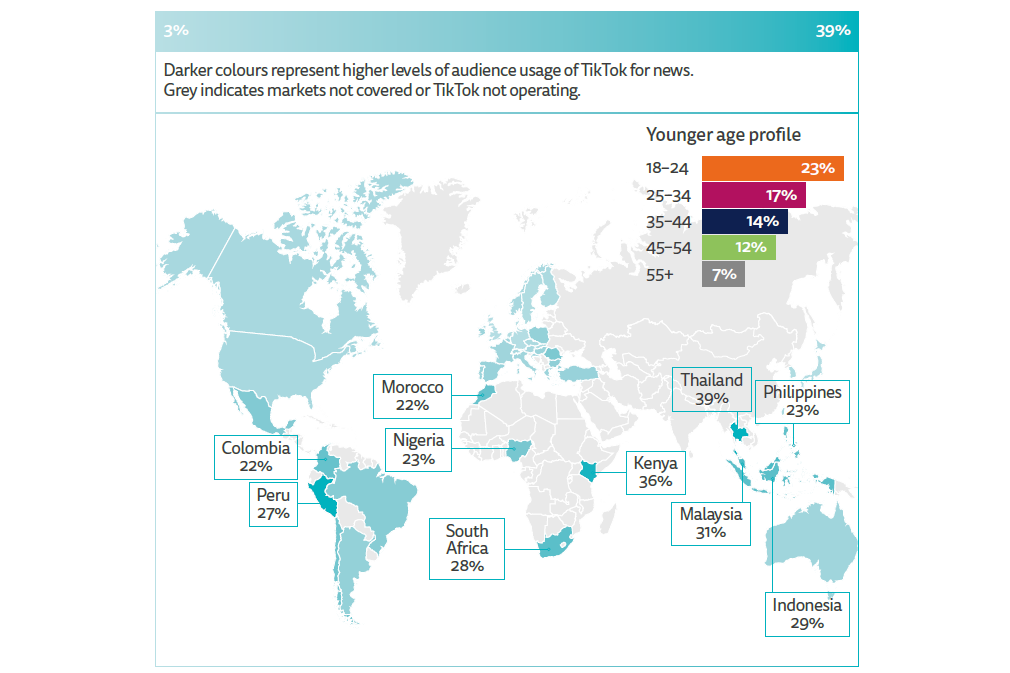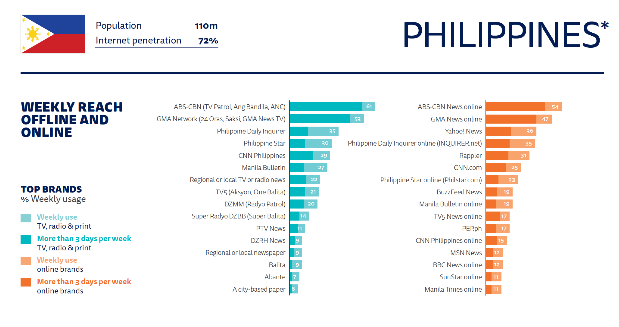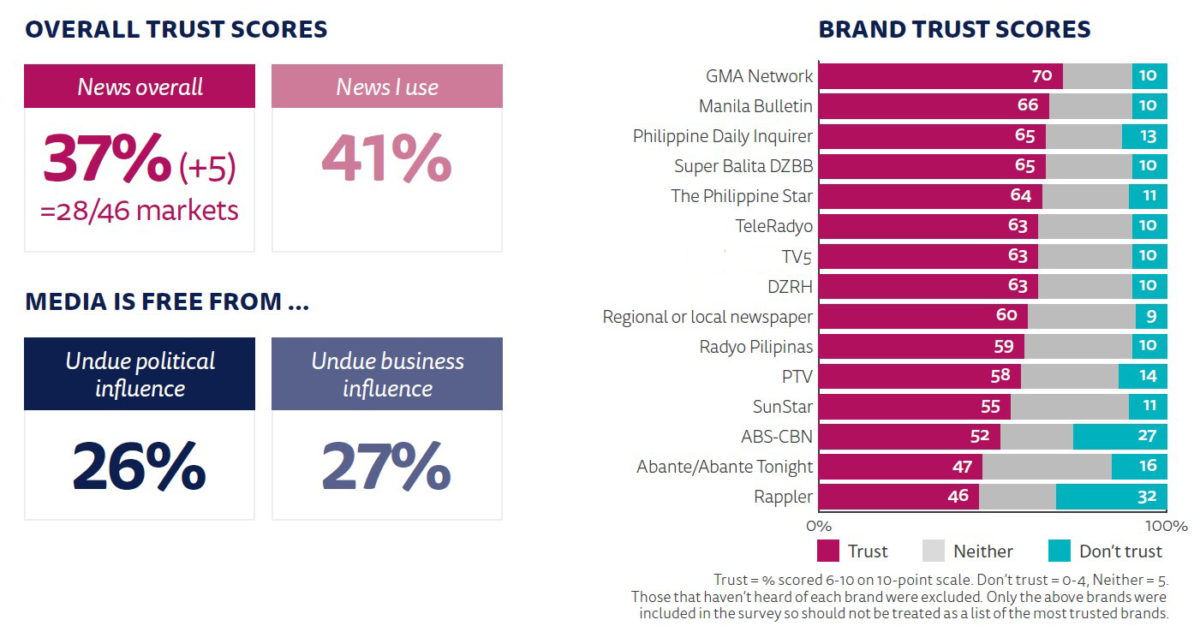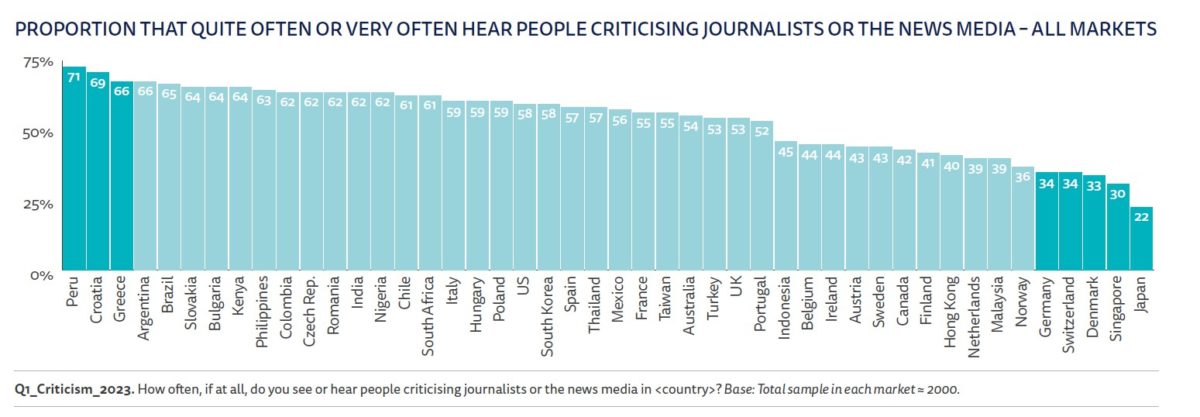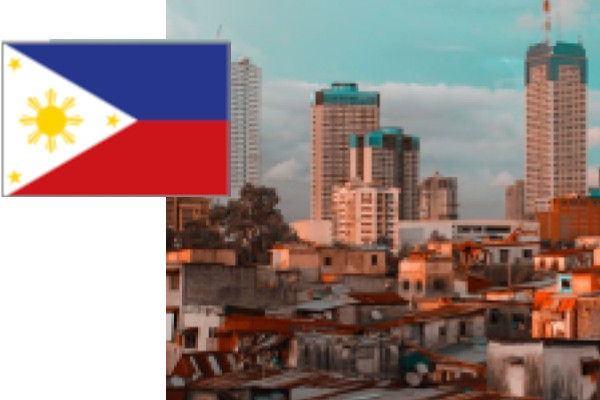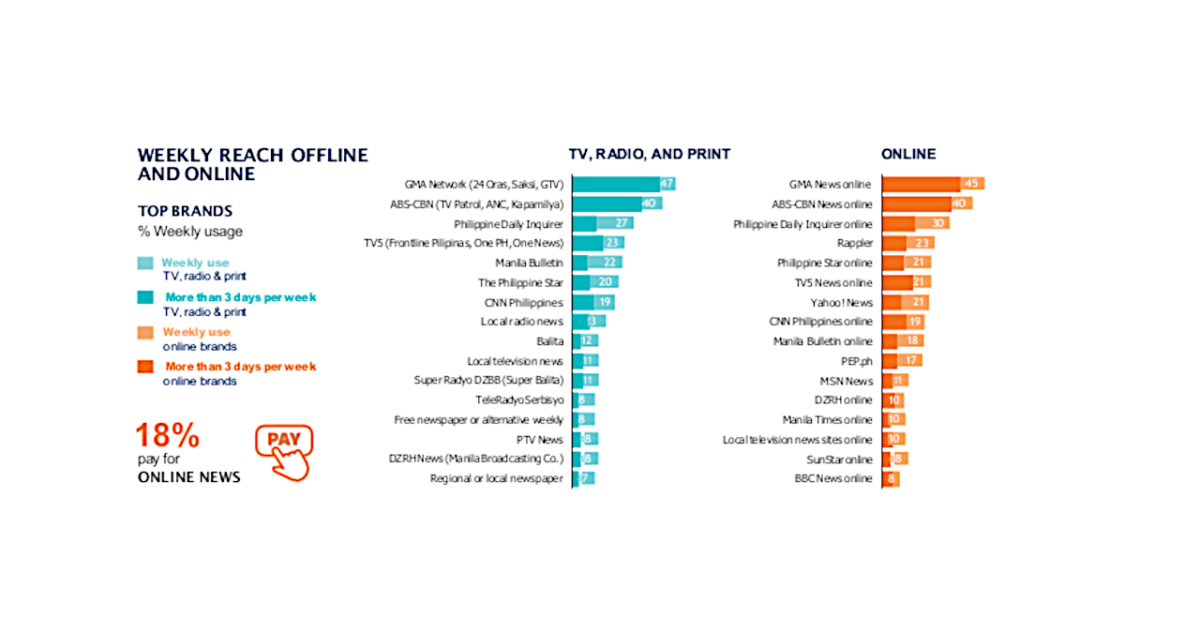Adult Filipinos are relying less on Facebook and other legacy social media platforms for news, increasingly turning to video-centric TikTok amid changing news consumption habits.
The trend mirrors the global decline in traditional social media usage for news as detailed in the Reuters Institute Digital News Report (DNR) released on June 17.
This year’s report also highlights the rising popularity of short news videos, diminishing prominence of mainstream news media and journalists on many social media platforms, and continuing loss of interest in news, coupled with concerns over misinformation, despite stable trust levels in news.
The report also noted that internet users across 28 countries generally feel uneasy about content generated by artificial intelligence (AI) even with some human oversight. However, they are less uncomfortable with AI assisting journalists for such tasks as transcribing interviews or summarizing research materials, it said.
The 13th edition of DNR, regarded as the most comprehensive global study of news consumption trends, draws data from an online survey conducted in late January to early February with 94,943 adults across 47 media markets participating, including 2,104 Filipinos.
For the first time in the Philippines, usage of Facebook as a source of news has plummeted from 72% to 61% over the past year, a significant 11 percentage point drop well above the average 4-point decline across all markets. (DNR does not consider differences of +/- 2 points as meaningful.)
Facebook has been the dominant social media platform in the Philippine digital space with a 94.6% monthly login rate among active social media users, according to Meltwater, an online media monitoring company.
DNR 2024 also found Filipinos shifting away from other traditional social media platforms for news: YouTube down to 45% (-10 points), Facebook Messenger to 26% (-7 points) and X, formerly Twitter, to 9% (-7 points).
The decline of Facebook and YouTube is even more pronounced among Filipino news consumers aged 18 to 24. Facebook has slipped from 71% to 56% (-16 points) and YouTube from 47% to 33% (-14 points) over the same period.
Top social, messaging and video networks in the Philippines

In contrast, TikTok has gained further traction in the Philippines, with its use for news rising slightly from 21% to 23%, surpassing the 13% average across all markets. This represents a 21-point increase since 2020 when only 2% of adult Filipinos used TikTok for news, placing the Philippines among the top 10 markets for TikTok as a news source.
Filipinos aged 18 to 24 have logged a higher usage rate of TikTok, climbing from 3% in 2020 to 30% this year–a substantial 27-point increase.
Philippines among top 10 markets that used TikTok for news in the last week
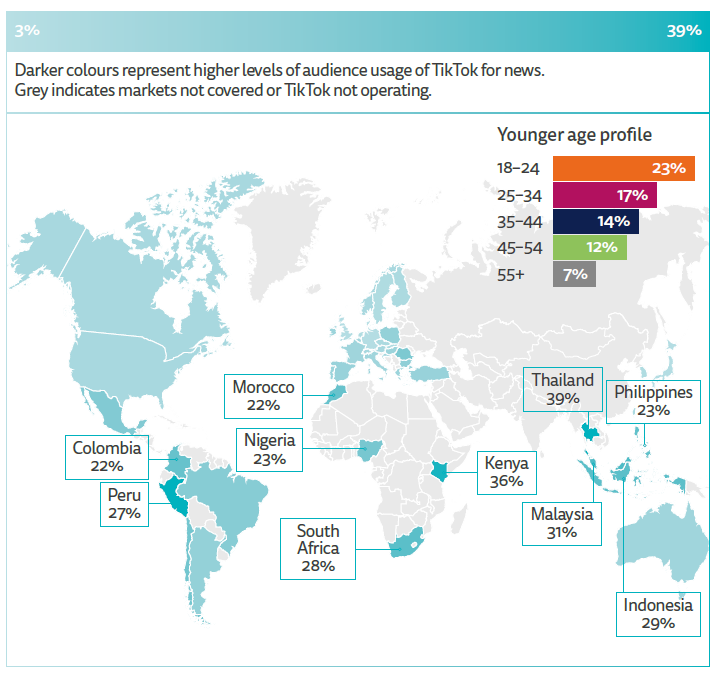
The fragmentation in news consumption is driven by several factors, including the rise of video networks and private messaging apps that offer more personalized and engaging news experiences, according to DNR 2024.
The decline in traditional social media’s role for news also coincides with ongoing “platform resets,” where legacy platforms like Meta (Facebook’s parent company) and X have been pivoting their focus from news and publishers to other content creators and types of engagement, it said.
“This more complicated platform ecosystem, the end of mass referrals from legacy social media, and growing competition for attention means journalists and publishers will have to work much, much harder to earn the public’s attention, let alone convince them to pay for news,” said Reuters Institute director Rasmus Nielsen.
Online and social media remain the most popular sources of news in the Philippines, but the proportion of Filipinos who access news through online platforms, including social media, has decreased to 82% from the previous year’s 85%. The reduction is higher for social media alone, with the share of news users falling 7 points over the past year to 63%.
TV news remains important for those who are not online, but its reach has contracted from 66% to 46% since 2020 when Congress chose not to renew the franchise of ABS-CBN Corp., forcing the country’s then biggest broadcast network to close its free radio and television operations.
ABS-CBN’s staggering financial losses have prompted recent partnerships with ALLTV, owned by business tycoon and former Senate president Manny Villar, and with Prime Media Holdings, associated with the family of Speaker Martin Romualdez, for its news programs. Earlier, it partnered with Zoe Broadcasting Network of Jesus is Lord Church.
Sources of news in the Philippines since 2020
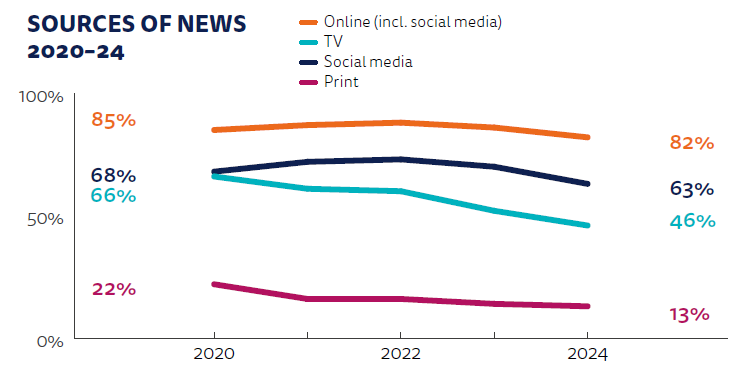
Short online news videos have become increasingly popular, especially among younger Filipinos, data from DNR 2024 show, highlighting the shift toward more accessible and engaging formats. Eight in 10 respondents reported watching short news videos weekly, a much higher rate compared to two-thirds of the global sample.
Nine in 10 adult Filipinos prefer hard news over soft news (67%) for short online videos. International news (48%) is the most frequently watched topic, followed by entertainment and celebrity (46%), health and wellbeing and environment and climate (44%), national politics (43%), and crime and security and education ( 41%).
Social media remains the leading platform for watching online news videos, with Facebook being the most used in the Philippines (46%) followed by YouTube (28%). Only 9% said they have watched news videos on TikTok, 8% on news sites or apps and a mere 3% on X. However, Filipinos aged 18 to 24 access news videos more on TikTok (15%) and less on YouTube (20%).
DNR lead author Nic Newman said traditional media across markets have some catching up to do as consumers increasingly favor video. “Many traditional newsrooms are still rooted in a text-based culture and are struggling to adapt their storytelling while the business side is also reluctant because the sums don’t add up,” he said.
The roles of online influencers and traditional journalists as news sources are likewise evolving rapidly. Across all markets, traditional news brands and journalists maintain a prominent position on platforms like Facebook and X, often ahead of influencers.
In the Philippines, the dynamics of news sources vary significantly. Mainstream journalists and media are the leading news sources on X and YouTube (each at 53%). However, on Facebook, journalists (40%) are outpaced by influencers (47%) and celebrities (44%). On TikTok, influencers (49%) and celebrities (47%) dominate as news sources, while on Instagram, celebrities lead (60%).
This contrast is even more apparent among Filipinos aged 18-24, where journalists and news media mostly lead only on X.
For this age group, the top three sources of news are also more diverse and include smaller or alternative media as well as politicians and political activists. For example, the proportion of those accessing alternative news media has increased to 35% on both YouTube (+16 points) and TikTok (+9 points). Accessing news through politicians and activists has risen 21 points to 48% on Instagram.
Proportion that pay attention to each for news on each platform in the Philippines, all ages
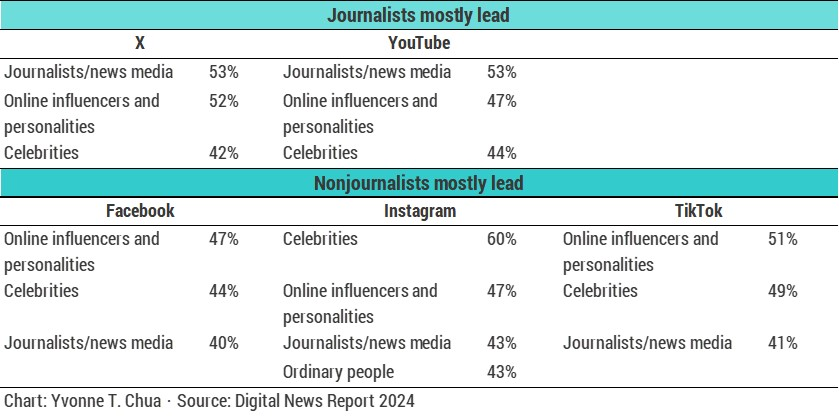
Proportion that pay attention to each for news on each platform in the Philippines, 18-24
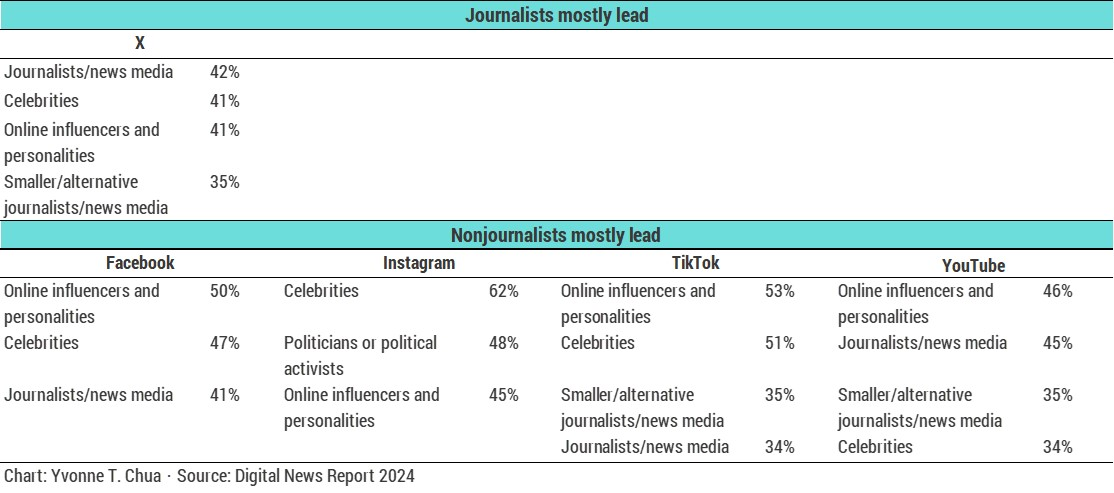
Across 28 countries that were asked about artificial intelligence (AI), awareness was notably higher among younger individuals, with 56% of respondents under 35 reporting substantial or moderate knowledge about AI. In addition, 52% of men and 54% of those with higher education levels indicated similar familiarity.
There is greater discomfort with using AI-generated news for hard news topics like politics (46%), crime (43%) and local news (37%). Discomfort is lower for soft news subjects such as arts and culture, celebrity and entertainment (each 29%), and sports (27%).
Interest in news continues to decline, reflecting a broader trend of news fatigue and selective avoidance. In the Philippines, only 46% of respondents this year reported being extremely or very interested in news, down from 52% in 2023. It is more noticeable among younger consumers, with interest among 18- to 24-year-olds dropping by 9 points from the previous year to 34%.
Local news (45%) leads in capturing the interest of news users in the Philippines, followed closely by international news (43%) and news about the environment and climate change (41%). Sports (27%) and social justice topics such as race and gender inequality and rights (21%) draw less interest.
News avoidance remains prevalent, with 47% of respondents in the Philippines indicating that they sometimes or often avoid news, a figure higher than the global average of 39%. The proportion of Filipinos who share news has fallen 5 points to 42%.
This year’s DNR examined “user needs” in news, categorizing stories into four groups: knowledge (engage, update), understanding (educate, provide perspective), feeling (divert, inspire), and doing (connect, help). The top responses across all markets are staying updated (72% on average), gaining more knowledge about topics and events (67%), receiving different perspectives (64%), and obtaining practical information and advice for daily life (60%).
In the Philippines, the priorities are similar: staying updated (72%), gaining knowledge (69%), and receiving practical information (68%). But respondents placed greater importance on news that makes them feel better about the world (66%).
Most important user need, all markets
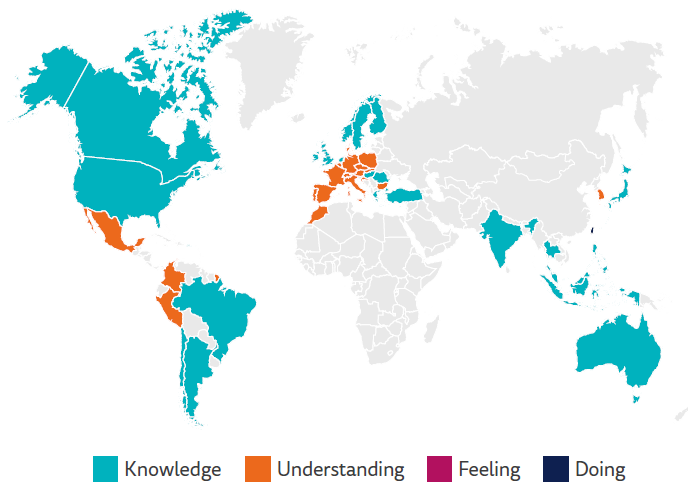
Concerns about online misinformation have increased across all markets, with 59% of respondents worried about distinguishing real news from fake news, up 3 points from the previous year.
In the Philippines, this concern is greater, with 63% of Filipinos expressing worry about misinformation. Filipinos report encountering misinformation on various topics at rates higher than the global average: politics (49%), COVID-19 (36%), economics and cost of living (33%), other health issues (27%), and climate change or the environment (26%). The proportion of Filipinos who have seen false or misleading reports about the Israel-Palestine conflict (27%) matches the global average.
Despite the challenges, trust in news remains relatively stable. Thirty-seven percent of respondents in the Philippines trust most news most of the time, consistent with global trends. Many of the longest-established media brands also enjoy relatively high levels of trust. However, public trust alone does not necessarily indicate the quality or trustworthiness of the content.
Many respondents are also confident in their ability to distinguish trustworthy and untrustworthy news and information on online platforms, this year’s DNR said. In the Philippines, the proportion who say they find it easy to do so ranges from 41% to 68%.
Nonetheless, a considerable number of respondents also struggle to pick out trustworthy news, especially on TikTok and X, which are known for hosting misinformation or conspiracies around stories such as the war in Gaza, as well as “‘deepfake” pictures and videos, the report noted.
Proportion that find it difficult to identify trustworthy news on each platform in the Philippines
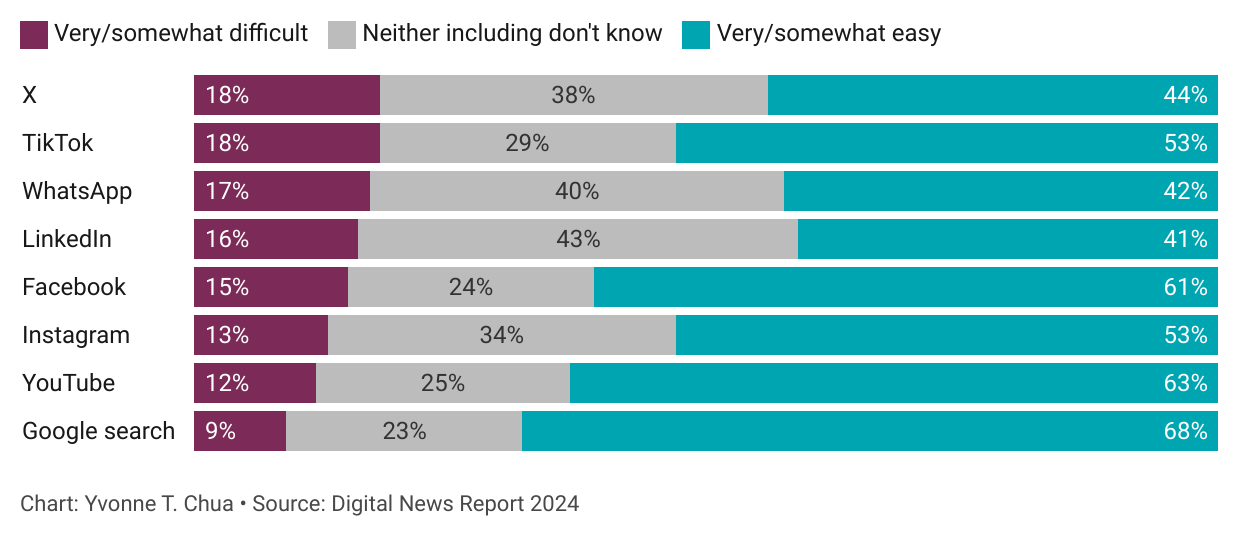
(Yvonne T. Chua is an associate professor of journalism at the University of the Philippines. She has been writing the profile on the Philippines for the Digital News Report since 2020.)
